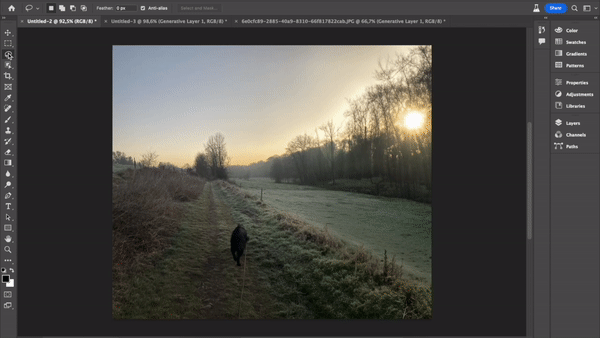In this edition of “Navigating the AI Dust Storm” we dive into the advances of Adobe Photoshop with some examples. We also touch on some recent industry events in this space and some of the tidbits from recent weeks.
Photoshop introduces AI
Leading the discussion this fortnight has been the release of Photoshop’s Firefly: its generative AI integration, allowing users to manipulate photos with a simple command, acted upon by the software with ease. The new release allows users to perform a variety of tasks with newfound prowess including text-to-image, generative fill, and sketch-to-image.
While the conversation regarding AI stealing from artists has been large and controversial, the new advance by Adobe has expanded the possibilities of AI being used as an artistic tool. This feature allows graphic designers, photo editors, and artists alike to make their visions a reality and to better create exactly what they desire.
While some features are more pronounced than others, we found that especially the generative fill showcased some of the best of the technology. Some use cases of this feature would be adapting photos shot vertically into a more wide screen-friendly view by adding on to the sides of the image (as below). Another use is adding space to either side of a focus point to ensure the subject is centred within the image.
As showcased by Le Monde, the most ambitious of features like text to image, are still needing to be worked through. Surely, as advances continue, these features will see improvements.
However, for the time being, Firefly seems to struggle with adding realistic figures into the scene. These inserted images from text seem to underwhelm in terms of realism and can seem, at times, like a drawing overlaid into the setting. As seen below, the insertion of a hot air ballon into the image requires retooling for realism.

Tech Talks
As ever in this blooming and quickly reacting industry, we are abound with talks, insights, and discussions of the latest in this space. Important to key into was the recent Nordic AI in Media Summit in Copenhagen, a sold-out event catering to, well, AI in media amongst the Nordics. In their Six things news publishers need to know, Press Gazette looks back at the learnings from this summit and distills some of the most important nuggets to take away.
Mediahuis’ Ezra Eeman, one of the featured speakers at our Twipe Digital Growth Summit, believes that trusted and legacy news brands are at an advantage in the AI in publishing space. As trust may be harder to come by in an age where misinformation is plentiful and cheap to create, the amount of trust that publishers hold is a valuable currency that some news brands have grown over large amounts of time. Eeman expressed that AI is first and foremost a tool to rid organisations of friction. This starts by identifying areas and problems which can be made easier and solved.
Another important comment from the summit is the value that AI can add to inclusivity and accessibility. While bias is baked into AI systems as much as it is within those that create it, Yle News Lab revealed that they have been using AI for measuring and improving diversity in their content.
All the while, Aftenposten has been making journalism more accessible to groups of people struggling with reading news by cloning human voices to make the content more comprehensible for those with dyslexia or ADHD.
AI tidbits and experiments
It was revealed this past week that a New York lawyer will be facing a court hearing after deferring to ChatGPT in preparation of a legal brief. The lawyer in question, while creating a brief for a case involving a man suing an airline over an alleged personal injury, was unaware of ChatGPT’s ability to “hallucinate”. As a result, the lawyer submitted a brief including precedent based on several court cases which were entirely fabricated and not based in the real world.
While this case was discovered and well documented, this seems to be a growing trend beyond just the often lambasted potential of students to make use of the new technology. As AI’s proliferation becomes increasingly convincing and the technology more and more commonly used by the average technical novice, we can expect instances that were meant to be AI with a human in the loop to increasingly become AI with a human asleep at the wheel.
Using this instance as a jumping off point, Nicholas Thompson, CEO of The Atlantic, delves into a potential solution to this in his series The most interesting thing in tech. Thompson suggests competing chatbots be used to debate each other behind the scenes when their answers differ. This debate would cease once the chatbots had come to a mutual conclusion, hopefully a more factual answer. This hopes to act as a way to catch out hallucinations, which should be isolated to a single chatbot, and to work towards a more satisfying conclusion. While this would add time and resources in computing power, as a premium feature, it could be useful.
A major update in the AI world has been that it may be paying off big time. Nvidia, a company behind much of the hardware fuelling the AI boom, has seen its value increase by $184 billion (yes, with a “b”) in a single day. This move should only bolster the confidence and, to an extent, hype, surrounding companies focusing on AI and the enabling of AI processes. Nvidia is now the sixth public company in the world valued at over $1 trillion, joining Apple, Saudi Aramco, Microsoft, Alphabet and Amazon.
With respect to AI experiments, this week we have come across perhaps the most underutilised capability of AI: making Greek statues come alive and dance.
From the perspective of leaders within the AI tech space, the regulation and attention pointed towards AI should be on par with that of pandemics and nuclear war. As told in an open letter, leaders believe in a non-zero chance of extinction of the human race at the hands of the new advancements in AI. This comes hot on the heels of the Senate hearing in the US regarding AI regulation, most notably led by OpenAI’s Sam Altman.
Nicolas Hall
Get Twipe’s weekly insights on digital publishing, artificial intelligence, and paid content in your mailbox. Sign up here.

